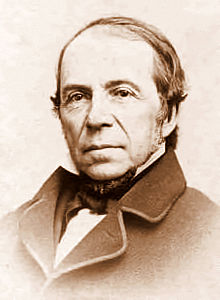Leo Lesquereux
Leo Lesquereux (born November 18, 1806 in Fleurier , Switzerland , † October 25, 1889 in Columbus (Ohio) ) was an American paleobotanist and bryologist . As a contributor to the Geological Survey of Pennsylvania and states in the Midwest and other states, he was one of the first to describe the North American carboniferous flora in the coal seams. Its official botanical author abbreviation is " Lesq. ".
Life
Lesquereux came from a French Huguenot family, was the son of a watchmaker and attended the college in Neuchâtel, where Auguste Agassiz (brother of Louis Agassiz ) and Arnold Guyot were his classmates and friends. His educated mother wanted him to become a Lutheran minister. However, at the age of ten, he suffered a fall that led to partial deafness. He had to earn school as a tutor. After graduating in 1827, he was a private tutor in Eisenach (he later intended to study) and a teacher at the college in La Chaux-de-Fonds in the Swiss Jura. In 1830 he married Sophia Freiin Wolfskeel v. Reichenberg, with whom he had four sons and a daughter. Two years later, he became completely deaf and had to give up teaching. He worked as a watchmaker for his father and turned to botany in his free time. The Swiss government offered a prize for essays on peat to improve the energy supply. His essay on peat formation in moors in 1844 (Quelques recherches sur les marais tourbeux en général), which he saw as a preliminary stage to coal formation, was awarded, attracted the attention of Louis Agassiz and, with the support of Prussia, he was able to conduct further studies on moors and coal deposits in Northern Europe perform. He wrote the first catalog of mosses in Switzerland (1845). He also began to be interested in fossil plants in coal seams after visiting Wilhelm Schimper in Strasbourg. When he lost his post as a result of the revolution of 1848, he emigrated to the USA following Louis Agassiz and Guyot (and invited by Agassiz) and settled in Columbus (Ohio) . Agassiz entrusted him with the classification of the plants he had collected at Lake Superior and the then leading bryologist in America, William Starling Sullivant , a wealthy businessman in Columbus, Ohio, used him for his bryological work (Musci boreali americani, 1856, 1865, Icones muscorum 1864) . In 1849 he traveled to the southern United States for Sullivan. He sold watches and jewelry, and studied mosses and fossil plants, working with state geologists in several states (Pennsylvania, Arkansas, Mississippi, Illinois, Indiana, North and South Dakota). He was active as a field geologist until 1884, but never had an official position as a geologist. 1867 to 1872 he arranged the fossil collection (especially the paleobotany) of the Museum of Comparative Zoology at Harvard University under Louis Agassiz. He was also commissioned by the private collector RD Lacoe in Pittston, Pennsylvania to organize his fossil collection (it later went to the National Museum of Natural History ).
From 1849 onwards he published letters from America addressed to Swiss willing to leave the country and published in the Revue Suisse in Neuchatel (as a book in 1853). With Sullivant he started a manual of the mosses of North America, which was interrupted by the death of Sullivant in 1873 and the declining eyesight of Lesquereux. Finally he continued it with Thomas Potts James , who took over the microscopic examinations essential for the classification. The manual described around 900 species and appeared in 1884. He is considered the first paleobotanist in North America and published on the Carboniferous Mountains of Pennsylvania (1854) and Illinois (1863), and there in particular the later famous Mazon Creek fossil site near Morris (Illinois) . From 1879 his extensive three-volume monograph on the carbonaceous flora of Pennsylvania was published.
In 1861 he became a member of the American Philosophical Society , in 1864 of the National Academy of Sciences and in 1871 of the American Academy of Arts and Sciences . Among other things, the plant genus Lesquerella is named after him. Its collections are partly at the University of Neuchatel (Neuchâtel), at the New York Botanical Garden and Harvard University.
Fonts
- Catalog des mousses de la Suisse, Neuchâtel: Société des sciences naturelles (printed by H. Wolfrath), 1845
- Quelques recherches sur les marais tourbeux en général, Neuchâtel: H. Wolfrath, 1844
- Lettres écrites d'Amérique destinées aux émigrants, Neuchatel: H. Wolfrath 1853
- On Californian mosses, American Philosophical Society, 1863
- with William Starling Sullivant : Musci Boreali Americani, 1856, 2nd edition Columbus / Ohio 1865 (new edition Strasbourg 2016)
- The fossil plants of the coal measures of the United States: with descriptions of the new species, in the cabinet of the Pottsville scientific association, Pottsville: B. Bannan, 1858
- Description of the Coal Flora of the Carboniferous Formation in Pennsylvania and throughout the United States, Harrisburg: Board of commissioners for the second Geological Survey, 3 volumes, 1879 to 1884
- Atlas to the coal flora of Pennsylvania, and of the carboniferous formation throughout the United States, Harrisburg: Board of Commissioners for the Second Geological Survey, 1879
- with Thomas P. James: Manual of the mosses of North America. With six plates illustrating the genera, Boston: SE Cassino and company, 1884
literature
- Joseph Ewan: Leo Lesquereux, in: Dictionary of Scientific Biography , Scribner's, from 1970
Web links
- Biography and Autobiography, American Philosophical Society
- Edwin Urmi, Erwin Neuenschwander: Leo Lesquereux. In: Historical Lexicon of Switzerland .
- Entry at IdRef
- Clark Kimberling biography, with photo
| personal data | |
|---|---|
| SURNAME | Lesquereux, Leo |
| BRIEF DESCRIPTION | American paleobotanist and bryologist |
| DATE OF BIRTH | November 18, 1806 |
| PLACE OF BIRTH | Fleurier , Switzerland |
| DATE OF DEATH | October 25, 1889 |
| Place of death | Columbus (Ohio) |
